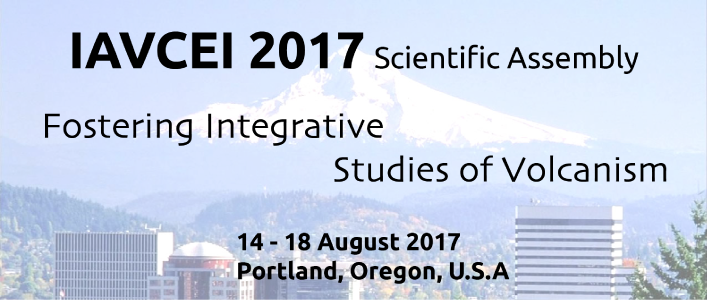SCIENTIFIC PROGRAM SESSIONS
I. Magmatism and tectonism
I.2 Relating magmatic-tectonic processes and volcano flank stability
I.3 How good are volcanoes at sampling magmatic systems in space and time?
I.4 Arc evolution: space, time, morphology, and longevity of volcanic arcs
II. Using geophysics and geochemistry to probe magmatism and eruption processes
II.1 Viscous Lava Flows and Domes: Multi-disciplinary Studies of Emplacement Mechanisms
II.2 Basaltic eruption styles and transitions in intensity: from driving processes to impacts
II.3 Active Lava Lakes: A Window into the Deep?
II.6 Volcanism and magmatism under water or ice
(Sponsored by the Commission on Submarine Volcanism)
II.7 Architecture of magmatic plumbing systems
II.9 Continental large igneous provinces: understanding processes of magma formation, storage, evolution, and eruption
(Sponsored by the Commission on LIPs)
II.10 A tribute to the life and work of Jon Davidson (1959-2016)
III. From precursors to eruption
III.1 Forecasting volcanic eruptions
III.2 Geophysical multi-parameters techniques for monitoring active volcanoes
(Sponsored by the Commission on Volcano Seismology)
III.3 Multidisciplinary constraints on volcanic eruption triggers
(Sponsored by the Commission on Monogenetic Volcanism)
III.4 Wet volcanoes: aquifers and lakes and their related hazards
III.5 Processes leading to monogenetic volcanism
(Sponsored by the Commission on Monogenetic Volcanism)
III.6 Linking monitoring data with volcanic processes
III.8 Progress in understanding submarine volcanism
(Sponsored by the Commission on Submarine Volcanism)
III.9 Understanding pyroclastic density currents through analysis of their deposits
IV. Volatile influences on eruption style, degassing, atmospheric chemistry and climate
IV.1 Remote sensing of volcanic gases from space-based, airborne and ground-based platforms
IV.2 Sulfides in volcanic systems: implications for sulfur and trace metal budgets of eruptions
IV.3 The role of volatiles and degassing in magmatic and eruptive processes
IV.4 Volcanic plumes and clouds: from injection to dispersion
IV.5 The role of volatiles in volcanic systems of the Earth's lithosphere
V. Evaluating volcanic hazards
V.1 Lava flow dynamics and hazard assessment
V.2 Volcano geomorphology and sedimentology: topography, processes, and deposits
V.3 Modelling volcanic hazards
(Sponsored by the Commission on Statistics in Volcanology)
(Sponsored by the Commission on Volcanic Hazards and Risk)
V.5 Evaluating hazards by mapping and interpreting volcanic deposits
(Sponsored by the Commission on Volcanic Hazards and Risk)
V.6 Volcanic ash and gas: Generation, transport and impacts on infrastructure, aviation, and climate
V.7 Volcano geology and geological mapping as tools for unravelling volcanic history and long term hazards assessment
(Sponsored by the Commission on Volcano Geology)
VI. Volcanoes, energy and resources
VI.1 Volcano-hydrothermal system dynamics: Hazards, resources, and extremophiles
VI.3 Application of geological mapping and field surveys to different exploitation contexts (geothermal and ore deposits)
(Sponsored by the Commission on Volcano Geology)
VII. Volcanoes and human societies
VII.1 Managing Volcanic Risk in Developing Countries: Benefits from Community Based Risk Strategies
(Sponsored by the Commission on Cities and Volcanoes)
VII.2 Volcanic geoheritage
(Sponsored by the Commission on Volcano Geoheritage and Protected Volcanic Landscapes)
VII.3 Start spreading the news: Diverse and effective methods for communicating about volcanoes
VII.4 Integrated volcanic risk assessment
(Sponsored by the Commission on Cities and Volcanoes)
(Sponsored by the Commission on Volcanic Hazards and Risk)
VII.5 Health roles in volcanic crises: looking back, looking forward
VII.6 Successful information coordination among scientists, civil protection groups, and local officials during a crisis
(Sponsored by the Commission on Cities and Volcanoes)
VIII. Future thinking - what's on the horizon that could be a game-changer?
VIII.1 New approaches using statistical methods in volcanology
(Sponsored by the Commission on Statistics in Volcanology)
VIII.2 Drones and robots in volcanology
VIII.3 Volcano databases: new developments and applications
(Sponsored by the Commission on Volcano Geology)
VIII.4 Visualization Tools And Image Processing In Volcanology


